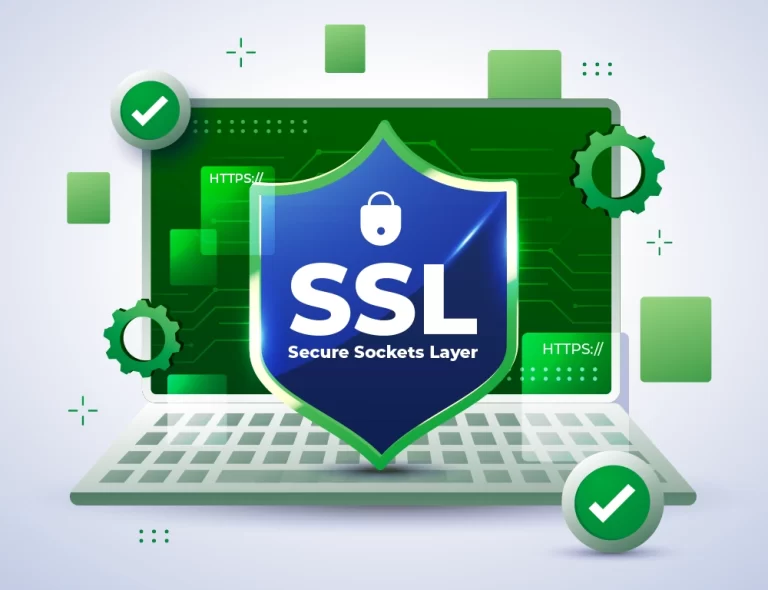A Guide to SSL Certificates
Table of Contents
Introduction
In an era where online threats loom large, it’s crucial to understand whether the websites we access are secure.
Those who visit websites on a regular basis are aware that website URLs either start with “http://” or “https://”. But have you wondered what sets them apart?
This is where SSL certificates come into play. When you see a website’s URL starting with “https://”, the ‘S’ denotes that it’s a secure site. This is because the site utilizes the SSL certificate.
Over 292 million SSL certificates have been detected on the Internet as of December 2023. They’ve increased by a whopping 40 million in just two years.
Let us demystify the basics of the SSL certificate’s meaning, the various types available, and the step-by-step process of obtaining it in this article.
What is an SSL Certificate?
An SSL (Secure Socket Layer) certificate is a digital padlock that ensures a secure connection between a user’s web browser and the server hosting a website.
The purpose of an SSL certificate is to create a security measure for protecting sensitive data exchanged between the user and the website.
When a user accesses the website – and shares sensitive info, like passwords or credit card details, the SSL certificate encrypts that data.
When you visit a website with an SSL certificate, the connection between your browser and the site is encrypted.
This makes it harder for hackers or malicious entities to access sensitive data like login credentials, credit card information, or personal details.
It is particularly essential when handling online transactions, user logins, or any other activities involving private information.
Over 90% of all phishing websites use HTTPS. So long story short, SSL certificates are secure guardians of your website, making sure your visitors’ data is safe and sound.

Why an SSL Certificate is Required
You might ask yourself “Do I need an SSL certificate for my website?” The answer is, you do. Here’s why:
An SSL certificate is used for ensuring the data security and privacy exchanged between a user’s browser and a website’s server.
It encrypts the information transmitted so that it remains unreadable to unauthorized parties even if intercepted.
Moreover, search engines like Google prioritize secure websites, meaning having an SSL certificate can positively impact your site’s search engine ranking.
It also builds trust with your users; when they see the padlock icon in the address bar, they know their data is being transmitted securely.
Types of SSL Certificates
SSL certificates come in various flavors, catering to different security needs and use cases on the web.
Understanding the types of SSL certificates is essential for website owners and administrators in need of an appropriate level of security for their online platforms.
From single-domain certificates suitable for basic websites to wildcard and multi-domain certificates that offer more extensive coverage, each type serves a unique purpose in safeguarding sensitive information and establishing trust with users.
Understanding the different types of SSL certificates is crucial for tailoring security measures to specific needs. Let’s break them down one by one:
1. Domain Validation (DV) Certificate
A Domain Validation (DV) SSL Certificate is the digital ID for your website. When you get one, it means a Certificate Authority (CA) has validated that you actually own the domain you claim to represent.
94.3% of SSL Certificates are Domain Validation. It’s a basic, entry-level security measure.
Here’s how it works: When you apply for a DV SSL Certificate, the CA sends a challenge to the domain owner to prove ownership.
This could be something like responding to an email sent to the domain’s registered email address or adding a specific DNS record.
Once you pass the test and prove that you’re in charge of the domain, the CA issues the DV SSL Certificate. Visitors to your website then see “https://” in the address bar, indicating a secure connection.
It’s a quick and straightforward way to add a layer of encryption to your site, ensuring that data exchanged between your visitors and your website is encrypted and secure.
2. Extended Validation (EV) SSL Certificate
An Extended Validation (EV) SSL Certificate is the VIP pass of online security for websites. It’s a type of digital certificate that provides the highest level of authentication and trust to website visitors.
When a website has an EV SSL Certificate, it triggers the browser to display a prominent green address bar, as an extra layer of security. To get this certification, website owners must go through a rigorous validation process.
This process involves verifying not only the domain ownership but also the legal identity of the entity behind the website.
Many e-commerce sites and businesses that handle sensitive customer information opt for EV SSL Certificates to build trust with their users and differentiate themselves from potentially less secure websites.
3. Organization Validated (OV) SSL Certificate
An Organization Validated (OV) SSL Certificate is similar to a digital security certificate for websites.
When you install this certificate, it means a Certificate Authority (CA) has verified not just your website’s encryption but also the legitimacy of your organization.
To get an OV SSL Certificate, your organization has to go through a bit of a background check, which is a more in-depth vetting process than the basic Domain Validated (DV) certificate.
The CA verifies your organization’s details, like its legal existence, physical address, and operational status. This extra check is what distinguishes the OV certificate. An OV SSL Certificate adds an extra layer of trust for your website visitors.

4. Unified Communications (UCC) SSL Certificate
Unified Communications (UCC) SSL Certificate is a type of SSL/TLS certificate designed to secure multiple communication channels under a single certificate umbrella.
In the modern business landscape, communication happens through various platforms such as emails, instant messaging, voice calls, and video conferencing. UCC SSL Certificates simplify the security aspect of these diverse communication channels.
For instance, if your business uses Microsoft Exchange for emails, Skype for Business for instant messaging, and a VoIP system for voice calls, a UCC SSL Certificate allows you to secure all these services with one certificate.
It’s a convenient solution that ensures data transmitted over these channels remains encrypted and secure, protecting sensitive information from potential threats.
5. Single Domain SSL Certificate
A Single Domain SSL Certificate is designed to secure a single domain or subdomain on a website. Hence, when you purchase a Single Domain SSL Certificate, it is issued specifically for one domain name.
It’s a cost-effective and straightforward solution for websites that have a single domain and don’t require protection for multiple subdomains.
Once installed on the web server hosting your domain, it activates the secure “https://” protocol in the URL and typically displays a padlock icon in the browser’s address bar.
This visual indicator reassures users that their connection to your website is encrypted and secure, fostering trust and confidence
6. Wildcard SSL Certificates
When you have a website with varied subdomains, a Wildcard SSL lets you secure them all with one certificate.
Here’s the scoop: SSL is all about encrypting the data between your website and its visitors, making sure sensitive info stays private.
But what if your site has multiple subdomains? Instead of getting separate SSL certificates for each (which could be a real hassle), you can go Wildcard.
Without a Wildcard SSL, you’d need to manage certificates for each subdomain individually. With a Wildcard SSL, it’s a one-size-fits-all deal.
How to buy an SSL Certificate?
Here’s a simple guide on how to buy an SSL certificate:
- Identify Your Website’s Needs: Before diving in, assess your website’s requirements. If it’s a basic blog or personal site, a standard Domain Validation (DV) SSL might suffice. For more business-oriented or e-commerce sites, you might want the added trust of an Extended Validation (EV) certificate.
- Choose a Reputable SSL Provider: Opt for a well-known SSL certificate provider. Companies like Sectigo, DigiCert, and Let’s Encrypt are recognized and trusted in the industry. You can purchase SSL certificates directly from their websites.
- Select the Type and Encryption Level: Decide on the type of SSL certificate based on your needs – DV, OV, or EV. For most websites, a DV certificate is practical. Also, ensure the certificate offers at least 2048-bit encryption, which is the current security standard.
- Verify Your Domain: After choosing a certificate, you need to verify that you own the domain. This often involves responding to an email sent to the domain owner or uploading a file to your website. It’s a simple step to confirm your identity.
- Purchase the SSL Certificate: Once your domain is verified, you can proceed to purchase the SSL certificate. During this process, you might need to provide some basic information and choose the duration of the certificate (1 year, 2 years, etc.).
- Receive and Install the Certificate: After purchase, the SSL provider will send you the certificate files. You need to install these files on your web server. Some providers offer guides or even automated tools to make this process straightforward.
- Update Your Website Settings: After installation, update your website settings to use the secure HTTPS protocol. This involves a simple change in your website’s configuration or content management system settings. Ensure that all internal links also use HTTPS to maintain a consistent and secure browsing experience.
- Check and Renew: Confirm that your SSL certificate is working correctly by visiting your website with “https://” and checking for the padlock icon in the browser. SSL certificates typically have an expiration date, so set a reminder to renew them before they run out.
By following these steps, you’ll not only secure your website but also assure your visitors that their data is in safe hands.
How to renew an SSL certificate?
Renewing an SSL certificate is a crucial task to ensure uninterrupted security for your website. Here are the general steps to renew an SSL certificate:
- Check Expiration Date: Most certificates have a validity period of one or two years. Monitor the expiration date of your current SSL certificate.
- Contact Your SSL Certificate Provider: Reach out to the Certificate Authority (CA) where you initially purchased the SSL certificate.
- Initiate the Process: Navigate to the renewal section on the website of your SSL certificate provider. This could be a dedicated renewal page or part of your account dashboard.
- Verify Domain Ownership: Some certificate providers may need you to verify the ownership of the domain again. This involves responding to an email sent to the domain owner or uploading a specific file to your website.
- Generate a Certificate Signing Request (CSR): If you are changing your server or hosting provider, you may need to generate a new CSR. This is a code that you provide to the SSL provider to generate the renewed certificate.
- Receive and Install the Renewed Certificate: Once the renewal is processed, the SSL provider will issue a renewed certificate. Download the new certificate files and install them on your web server. Some providers offer automated installation tools to simplify this step.
- Update Website Settings: After installing the renewed certificate, make sure your website settings are updated to use the new certificate. Ensure that your website is configured to use “https://” to maintain a secure connection.
- Test and Verify: Perform thorough testing to ensure that the renewed SSL certificate is functioning correctly. Check the browser for the padlock icon and verify that the SSL connection is secure.
- Update SSL Monitoring and Alerts: If you use any monitoring or alert systems related to your SSL certificate, make sure to update them with the new certificate information.
- Documentation: Keep a record of the renewal process, including the new certificate details, expiration date, and any relevant information. This documentation can be valuable for future reference.
By following these steps, you can smoothly renew your SSL certificate, ensuring continued protection for your website and maintaining a secure online environment for your users.

Can an SSL Certificate be Used on Multiple Servers?
SSL certificates can indeed be used on multiple servers. The flexibility to use a single SSL certificate across multiple servers is crucial for businesses with distributed infrastructure or those managing multiple subdomains.
The key here lies in the type of certificate you choose. Two common types that facilitate this are wildcard SSL certificates and multi-domain SSL certificates.
- Wildcard SSL Certificates: These certificates are the master keys. For example, if you have subdomains like blog.yourwebsite.com and shop.yourwebsite.com, a wildcard certificate like .yourwebsite.com can secure them all.
- Multi-Domain SSL Certificates: Also known as Subject Alternative Name (SAN) certificates, these allow you to secure multiple domains and subdomains with a single certificate. If you own multiple websites like yourwebsite1.com, yourwebsite2.com, and so on, a multi-domain SSL certificate can cover them under one umbrella.
Conclusion
As the digital realm advances, so do cyber threats. Implementing an SSL certificate is not just a recommendation, it’s a necessity for any website to prioritize a safe and reliable environment for its users.
Whether you choose a Single Domain SSL for a personal blog or invest in a Premium SSL for an e-commerce site, the decision to implement SSL gives rise to a safer and more trustworthy online presence.
Here’s to safer browsing and transactions, and a web presence that stands strong in the face of evolving cyber challenges.
We create inspired websites that entice your customers and expand your brand identity. Here’s your chance to create the site of your dreams.







